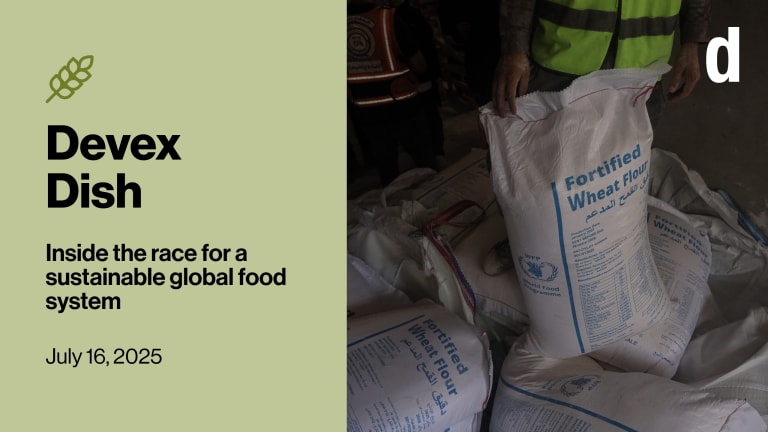
CANBERRA — Lawrence Haddad, executive director of the Global Alliance for Improved Nutrition, believes data on the consumption of animal-source food is highly reliant on figures from high- and middle-income countries. And this creates challenges in policy supporting increased consumption of such food in low-income economies.
“The consumption of animal-source food is really important for young children, especially in low-income settings,” Haddad told Devex. “And that will continue to be the case. But high-income countries probably eat too many animal-source foods. and they need to reduce that in line with the food guidelines of their own countries.”
“Diet is one of the big drivers for health as well as climate emissions, but we don’t know much about what people eat.”
— Lawrence Haddad, executive director, GAINThe EAT-Lancet diet supports Haddad’s view and the transformation required for the global food system. But it is unknown whether this change — increasing animal-source food for low-income countries and decreasing it for high- and middle-income countries — will balance, increase, or decrease carbon emissions from the agricultural sector, which Haddad said is responsible for one-quarter to one-third of emissions currently.
“It’s one of the unanswered questions, and I haven’t seen any research on what that is going to do overall,” he said. “My guess is that it will even out globally — but it’s an inequality story on who is best able to reduce their consumption of animal food sources and who has the best capacity to reduce from a greenhouse gas perspective. And this is the high-income countries.”
A lack of data
According to Haddad, the challenge in the conversation about balancing the food system is the lack of data. In preparing a presentation for the Brisbane audience at the Global Alliance for Improved Nutrition’s International Tropical Agriculture Conference, he said 98% of his data was from high- and middle-income countries. For low-income countries that require their own data to support decision-making, this creates a problem.
“One of the things that is really missing is diet data, which is really strange,” Haddad said. “Diet is one of the big drivers for health as well as climate emissions, but we don’t know much about what people eat.”
GAIN is working with the Gallup Foundation and Harvard University to help fill the gaps in this data to create the first-ever diet quality indicator for 140 countries every year. The United Nations is also working toward generating more diet data to fill these gaps and improve food-choice knowledge.
“We not only have gaps in what and how people buy produce, but we know even less about why they consume it,” Haddad said. “The private sector has spent loads of time and money doing consumer research, but the public sector does very little. All of our behavior-change programs designed to shift diets from one thing to another are all based on left-brain thinking — very logical rather than the whys. And very often health is the last thing associated with a purchase.”
Through the GAIN data in particular, Haddad says he is hopeful about providing insight into food decisions based on demography, geography, socioeconomic status, and more. And for countries that have been making inroads into hunger to only now be “hit over the head” by people such as Haddad telling them to also consider quality, they would have relevant insights that could help them leapfrog issues of obesity and diabetes that other countries are facing.
“Where you start from does matter,” Haddad said. “In North America and Europe, we are eating food that is highly processed, high in salt, and not eating enough fruits and vegetables and nuts. But, wherever you are in the world, changing diets are hard because it’s culturally ingrained.”
With the right data, Haddad believes governments can begin to counter the work of the private sector in influencing food choices.
“The way to do it is to change the food environment where they come face-to-face with their food choices. Are health options available, and are they affordable? Are they tasty and convenient? And are they made to be desirable and sexy? The food environment makes it easier for people to make healthy choices.”
Overcoming research confusion
An additional challenge, according to Haddad, is the confusion of research that can produce conflicting recommendations on the best methods of food production, and on what is healthy and what is not.
“It is surprising to me how much variation there is between what studies say,” he said. “And this is seeing huge variation in greenhouse gas emissions based on the recommended food-production methods. There is a move now for an intergovernmental panel on agriculture and food systems, and I think that is a good idea. We need something that will hammer out the consensus on what the evidence is saying.”
For low-income countries especially, this will help build consensus on what is best practice. And it will help cut through the noise about the food system for the three worlds that Haddad said are colliding: the undernutrition world of hunger and micronutrient malnutrition; a second world of malnutrition that is leading to obesity, chronic disease, and diabetes; and a third world of the environment.
“These three worlds are colliding, and there is a lot of dust in the atmosphere. We need something that is going to help us get a more settled picture on what the evidence is telling us,” he said.
And this will help build the evidence base for how a global balanced diet can benefit the environment — and which economies will need to do the heavy lifting to reduce emissions.
This focus area, powered by DSM, is exploring innovative solutions to improve nutrition, tackle malnutrition, and influence policies and funding. Visit the Focus on: Improving Nutrition page for more.








